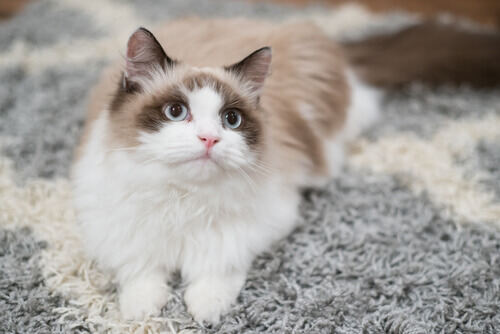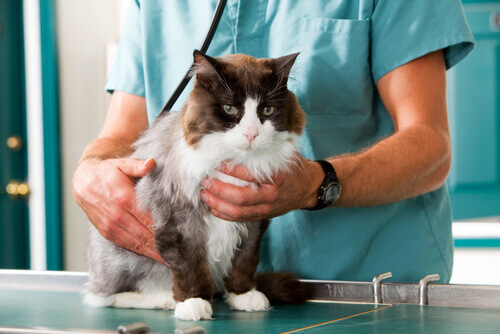Does Your Cat Cough? It Could Be Feline Asthma

Does your cat have a dry cough? You may also notice other similar symptoms such as gagging, retching, wheezing, or difficulty breathing. If your cat coughs, it could be a sign of feline asthma, a type of chronic bronchitis that doesn’t have a cure. However, it can be controlled if you start to treat it early.
Feline asthma, which has some similar characteristics to human asthma, can often be confused with furball problems. Furballs happen when the cat’s fur builds up in its stomach because of the cat’s constant licking and cleaning itself. Furballs are a separate issue not related to feline asthma.
Affected animals
Although it’s more common for feline asthma to appear in cats younger than 8 years old, it can attack young, old, male and female alike. Researchers haven’t confirmed if there’s a genetic aspect to the disease. However, cats with flatter faces or breeds such as Persians, Himalayas, and Siamese cats can be more susceptible.
Early diagnosis is essential. When a cat coughs, it may be due to feline asthma, which is also known as chronic or allergic bronchitis or bronchial asthma. It’s also called chronic obstructive pulmonary disease.
Feline asthma is the inflammation and narrowing of the lower airways (the lungs). This happens because of an overreaction of the immune system to allergens. It may be mild, moderate, severe, or life-threatening.
What can cause feline asthma?
- Pollen from trees or grass
- Hair sprays, deodorants, or flea powder
- Cigarette or chimney smoke
- Dust from kitty litter, especially scented litter
- Mold
- Dust mites
- Cleaning products
- Stress, obesity, cold, heat, and exertion may also be triggers
Early diagnosis
With regards to the physical aspects, some other factors can also influence feline asthma.

- A smaller bronchial tree in comparison to the cat’s size
- More smooth muscle in the bronchial walls
- A greater proportion of elastic cartilage and more globose cells
- Submucosal glands and mast cells
According to some studies, these factors affect between one and five percent of domestic cats. Some parasitic lung infections can resemble feline asthma, so it’s a good idea to rule these out first.
What happens when a cat has feline asthma? The bronchial tubes contract and produce mucus to try to trap the irritating dust particles. The body takes these two steps to prevent the particles from entering the lungs, and to eliminate them through coughing, respectively. The lungs’ contraction, added to inflammation, narrows the airways and causes difficulty breathing.
A dry cough isn’t the only indication of feline asthma. You might also notice fast, loud, or labored breathing, or a hissing or wheezing sound. If you notice your cat trying to breathe through its mouth, the risk is likely higher. And if you see your cat’s chest and abdomen moving irregularly and hear a hissing sound when it exhales, it’s probable your cat already has feline asthma.
Of course, an early diagnosis together with appropriate treatment will ensure the best outcome for your cat. However, if symptoms go unnoticed and the lungs undergo chronic degenerative changes, treatment will be more difficult. Remember that an asthma attack is life-threatening to your cat.
Detecting and diagnosing feline asthma
After you notice symptoms such as a dry cough or trouble breathing, your vet will likely order a series of tests. The purpose of these tests is to rule out other possible causes, such as lung parasites, bronchial pneumonia, neoplasms, or heart failure.
A chest x-ray will aid the diagnosis, as will a bronchoalveolar washing, which is a diagnostic method where fluid is introduced through the trachea to the lungs to examine the cells. This latter procedure is performed under general anesthesia.
Once feline asthma is confirmed, the treatment will likely include inhaled medicine, which works faster and has fewer side effects than tablets. Aerosol therapy removes bronchial mucus and improves breathing, while injections or immunotherapy serve to reduce the exaggerated sensitiveness that triggers the asthma attack.

Prevention and proper nutrition
It’s important to try to eliminate the allergens that are causing your cat’s immune system reactions. As we’ve seen, some causes may be secondhand smoke, insecticides, air fresheners, cold temperatures, and scented kitty litter or litter with a lot of dust.
Additionally, a balanced diet is essential. Specialists recommend eliminating dry food based on cereals and grains since these could be allergy or inflammation triggers. Also, if your cat’s overweight, its lungs will have to work harder.
With special care and strict treatment, your cat’s asthma won’t be life-threatening. Rather, you’ll be able to stabilize the disease and give your cat quality of life.
This text is provided for informational purposes only and does not replace consultation with a professional. If in doubt, consult your specialist.